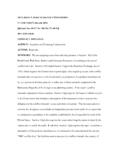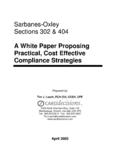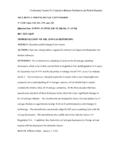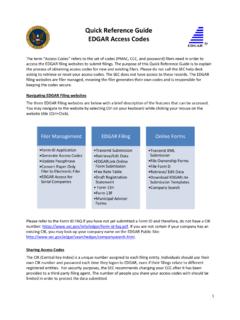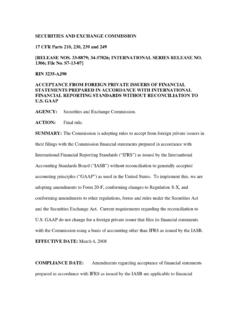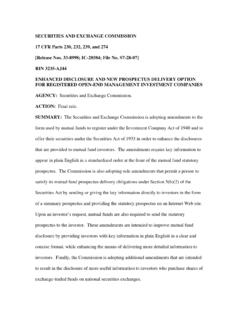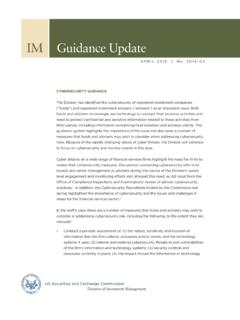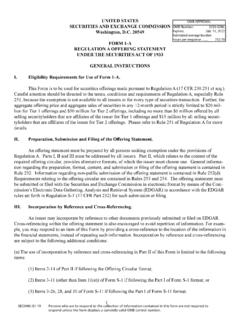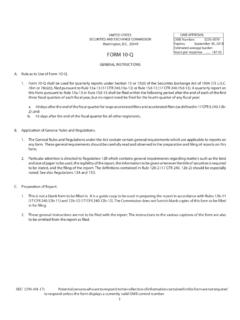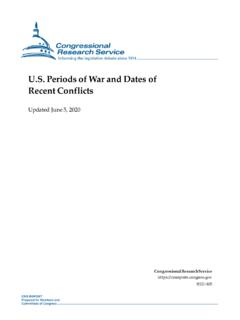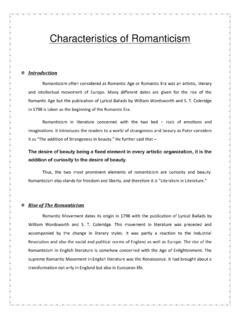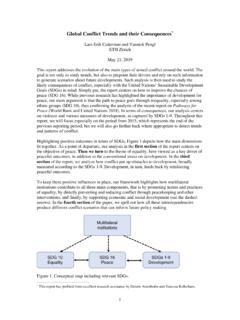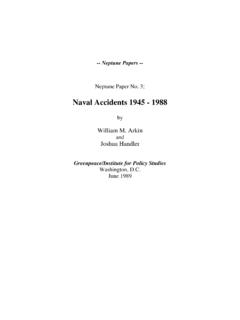Transcription of Division of Examinations Observations: Investment Advisers ...
1 November 10, 2021. Division of Examinations Observations: Investment Advisers ' Fee Calculations*. I. Introduction It is important for clients to receive timely and accurate information regarding fees and expenses when hiring an Investment adviser because every dollar an investor pays in fees and expenses is a dollar not invested for the investor's benefit. Thus, the staff from the Division of Examinations (the Division ) often reviews whether Advisers , among other things: have adopted and are following policies and procedures that are reasonably designed to result in the fair and accurate charging of fees; and have disclosed their fees with sufficient clarity for their clients to understand the costs associated with their services. 1. The Division recently concluded a national initiative that focused on advisory fees, predominantly those charged to retail clients ( Advisory Fees Initiative or Initiative ).
2 This Initiative assessed the various ways in which Investment Advisers charge fees for their services, as well as evaluated the adequacy of fee disclosures and the accuracy of fee calculations. 2 The staff conducted approximately 130 Examinations of SEC-registered Investment Advisers under this Initiative ( examined Advisers ) and identified deficiencies related to the advisory fees charged during most of these Examinations . The advisory fee-related deficiencies observed often resulted in financial harm to clients, including: (1) advisory fee calculation errors, such as over-billing of advisory fees, inaccurate calculations of tiered or breakpoint fees, and inaccurate calculations due to incorrect householding of accounts; 3 and (2) not crediting certain fees due to clients, such as prepaid fees * The views expressed herein are those of the staff of the Division of Examinations , formerly known as the Office of Compliance Inspections and Examinations or OCIE (the Division ).
3 This Risk Alert is not a rule, regulation, or statement of the Securities and Exchange Commission (the SEC or the Commission ). The Commission has neither approved nor disapproved the content of this Risk Alert. This Risk Alert has no legal force or effect: it does not alter or amend applicable law, and it creates no new or additional obligations for any person. This document was prepared by Division staff and is not legal advice. 1 The Division has identified disclosures regarding the costs of investing as an examination priority since 2018 (see Division , Examination Priorities for 2018, 2019, 2020, and 2021). 2 Other types of compensation, such as fees received in connection with client investments, were included within the scope of the Initiative to the extent that these fees related to the advisory fee calculations ( , advisory fees were to be reduced by any transaction-based compensation received by the Advisers ' supervised persons).
4 The staff also focused on additional compensation-based conflicts of interest identified during the Examinations , if applicable. 3 See, , In re Retirement Capital Strategies Inc., Advisers Act Rel. No. 5065 (Nov. 19. 2018) (settled) (alleging that the adviser inconsistently applied tiered breakpoints that reduced advisory fees as the total amount of client assets under 1. for terminated accounts or pro-rated fees for onboarding clients. In addition, the staff observed fee-related compliance and disclosure issues. The Investment Advisers Act of 1940 ( Advisers Act ) establishes a fiduciary duty for Investment Advisers . 4 Advisers that fail to adhere to the terms of their agreement and disclosures, or otherwise engage in inappropriate fee billing and expense practices, may violate their fiduciary duties and the Advisers Act, including its antifraud provisions.)
5 5. The Division previously published a Risk Alert highlighting compliance issues observed by the staff related to advisory fees ( Advisory Fees Risk Alert ). 6 In this follow up Risk Alert, the Division is supplementing the Advisory Fees Risk Alert by providing greater detail on certain compliance issues observed during the recent Advisory Fees Initiative Examinations , including additional details regarding the staff's observations in the two areas outlined above. II. Focus of Advisory Fees Initiative All of the examined Advisers provided Investment advice to retail clients; however, they had a wide range of assets under management, business operations, staffing levels, and affiliations. The scope of the Advisory Fees Initiative included a review of the examined Advisers '.
6 Compliance policies, procedures, and practices related to advisory or other fees charged and the related disclosures provided to clients. More specifically, examiners typically reviewed the following areas: The accuracy of the fees charged by the examined Advisers . The staff reviewed the accuracy of the advisory fees charged and whether the Advisers overcharged clients. The accuracy and adequacy of the examined Advisers ' disclosures. The staff reviewed the disclosures provided to clients related to the advisory fees billed, including whether certain types of assets should be excluded for fee billing purposes. 7. The effectiveness of the examined Advisers ' compliance programs and accuracy of their books and records. When reviewing Advisers ' compliance programs, the staff reviewed the management increased and failed to aggregate or household related account balances of the same client and clients within the same household for the purposes of achieving the advisory fee breakpoint discounts).
7 4 An adviser's federal fiduciary obligations are enforceable through Advisers Act Section 206. See, generally, Commission Interpretation Regarding Standard of Conduct for Investment Advisers , Advisers Act Rel. No. 5248 (June 5, 2019) ( Fiduciary Interp. ). 5 See Fiduciary Interp. supra note 4 ( The Investment adviser's fiduciary duty is broad and applies to the entire adviser-client relationship ). See also, In re Barclays Capital Inc., Advisers Act Rel. No. 4705 (May 10, 2017) (settled) (alleging that the adviser violated Advisers Act Section 206(2) by incorrectly calculating the advisory fees based on, among other things, a billing methodology that differed from the advisory agreements); In re Morgan Stanley Smith Barney, LLC, Advisers Act Rel.
8 No. 4607 (Jan. 13, 2017) (settled) (alleging that the adviser violated Advisers Act Section 206(2) by charging clients advisory fees that did not reflect negotiated discounts). 6 Division , Overview of the Most Frequent Advisory Fee and Expense Compliance Issues Identified in Examinations of Investment Advisers (Apr. 12, 2018). 7 See Fiduciary Interp. supra note 4 ( In order for disclosure to be full and fair, it should be sufficiently specific so that a client is able to understand the material fact or conflict of interest and make an informed decision whether to provide consent ). See also Advisers Act Section 207 (stating that it is unlawful for Advisers to make untrue statements or omit any material facts in applications or reports filed with the Commission).
9 2. adequacy of policies and procedures or other operational documents related to advisory fee billing practices and the calculation of assets under management used for fee billing purposes. 8 In addition, the staff reviewed policies and procedures related to the valuation of unique or hard-to-value assets. 9 Lastly, the staff assessed whether the examined Advisers made and kept books and records that were true and accurate. 10. An adviser that engages in inappropriate fee billing and other fee-related deficient practices may have regulatory implications beyond these areas of focus. Therefore, the staff recommends reviewing this Risk Alert in conjunction with the Advisory Fees Risk Alert and other SEC and staff-issued guidance for a discussion of the legal requirements and helpful resources regarding Commission actions and interpretative guidance relevant to this topic.
10 11. III. Staff Observations 12. While Investment Advisers continue to have assorted advisory fee arrangements and use a wide variety of calculation methodologies, the staff observed that the typical examined adviser: (1). had a standard fee schedule with tiered fee levels based upon assets under management; (2). quarterly assessed its advisory fees; (3) deducted advisory fees directly from clients' accounts;. (4) calculated fees based on the account value at the beginning or ending date of the billing period; (5) used software or third-party service providers to calculate fees; (6) documented advisory fees with clients through written advisory agreements or contracts; and (7) combined family account values when such actions resulted in lower fees ( , householding of accounts).

